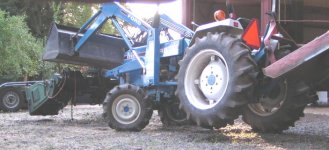MHarryE
Elite Member
- Joined
- Feb 15, 2009
- Messages
- 2,946
- Location
- Northeastern Minnesota
- Tractor
- Kubota M7-171, M5-111, SVL75-2, RTV900XT & GR2120; CaseIH 1680 combine
Harry,
I love sea stories like the one about the dual wheel combine's bearing failure. I note you have a Kubota that is about 5% heavier (but 20% more HP) than my Kioti. I looked at the bearing diagram you provided - the vertical load and the cornering load vectors. In another thread a happy customer of Motorsport-Tech.com, which machines custom spacers from blocks of high grade aluminum and has been doing so for 20 years, has a back and forth with some forumites in which the Motorsport-Tech rep states that the way his spacers attach does not unduly stress the wheel bearings. I jumped in that thread and publicly scratched my head because I'm trying to understand not only the physics of installing spacers - and associated risk of catastrophic premature failure and what that might mean on a hillside - but also whether a 3 or 4 inch spacer on each rear wheel even with premature wear/failure is such an enhancement to hillside bush hogging safety that it is a wise tradeoff. So I asked for further explanation in that thread and hopefully we'll hear more. I googled SKF, the swedish bearing manufacturer, and I see there is a calculator, but I am not an engineer and my cursory glance told me trying to calculate an outcome, and make sense of whatever that yielded in terms of risk/life of the bearing, is above my head. Are you interested enough to try and run some numbers for my (our) tractors *grin*? With FEL and bush hog and loaded rear tires I think my tractor is about 6,000 pounds.
I'm finding this subject pretty interesting!
Best,
Rhino
There are just so many unknowns, like what bearings are currently used, what is the spread, what are the static loads and what are the dynamic loads. Early in my career I was working on hillside combines. Our prototype failed a steering brake. We analyzed the failure, redesigned, and then had to test the new design before the machine went into production - but the harvest was over so how to test? We developed a test plan with severe figure 8 turns with extreme turning brake usage. New brake worked fine but we started popping bearings on the steering wheels. The side loading on the tires was so high when the steering brakes were used hard that it actually bent the spindles between the bearings so the bearings quickly failed. That loading was side loading equivalent to driving on a steep slope. So spacers for stability due to slopes - slope, tire loaded radius also enter in. It gets complex.
My opinion is to get your spacers and keep an eye out for oil leakage, wheel starting to tilt. There are things I swear would never work. I saw a Farmall Super A at an auction where the owner had built (very stout) a front end loader and installed duals front and rear. I absolutely know this won't work yet the owner used it for clearing snow for many years. Talk about front wheel bearing overload with a loader on a Super A plus duals on the front. International never put a loader of any kind on an A.
